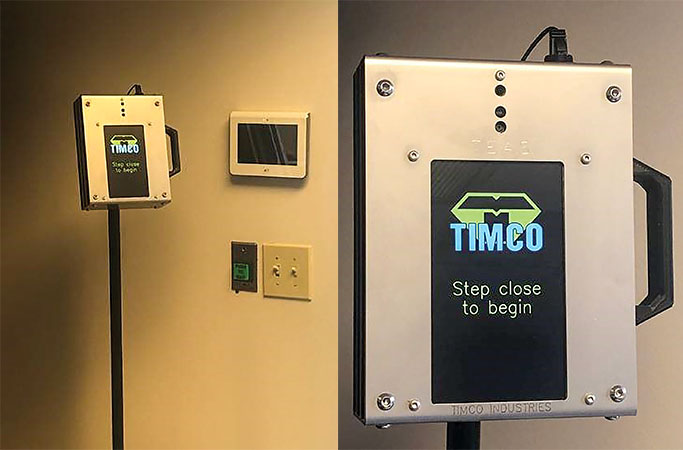TIMCO Industries’ new Temperature Entry Access System (T.E.A.S.) allows automated, touchless temperature taking with applications for the marine industry and beyond.
Claire Otter, vice president of TIMCO, based in New Albany, Ind., said the company saw the significant challenges and the impact COVID-19 was having on customers and immediately began strategizing, trying to come up with a way the company could help the industry.
“One of the few things we knew for certain about COVID was that mitigation tactics were working against the virus,” Otter said. “We focused our efforts on developing a tool to help companies supplement and automate their own prevention measures.”
T.E.A.S. screens employees, visitors and others to make sure their temperature is in a safe range before allowing them entry or access to an area. That is designed to save companies both time and money.
“There is a time and a cost efficiency in automating monotonous tasks, such as an employee assigned to taking and recording others’ temperatures,” Otter said, adding that hand-held thermometers may also be unreliable.
T.E.A.S. measures a person’s body surface temperature, without contact, prior to entry to an area. The infrared temperature sensor scans skin temperature from about 2 feet away, with results in two seconds. Instead of depending on a single reading, it takes multiple scans, then averages the skin temperature data. An elevated temperature, indicating possible illness, triggers an alert and enables quick precautionary measures. Alerts can be sent in real-time via text or email, and access can be limited or denied until further evaluation or a secondary screening is conducted. Temperature thresholds and protective measures are determined by each company’s specific health and safety protocols.
T.E.A.S. also offers optional customization to improve or integrate other functions, such as automating crew check-in/check-out, on/off vessel procedures, visitor tracking, foot traffic control in shipyards and capacity monitoring on passenger boats. The system can interface with door entry systems and attendance/timeclock management. It also includes essential contact tracing and datalogging capabilities.
Otter said the technology could reduce time and possible exposure for passengers waiting to board excursion boats, cruises or other passenger vessels and also has applications outside the marine industry, such as at schools, daycares and offices.
Nate Poindexter, who oversees sales for TIMCO, said TIMCO already provides equipment that monitors critical engine parameters, including temperature, and communicates that information remotely through its cloud-based service. The T.E.A.S. unit was the result of adapting that technology within medical-grade guidelines to detect a person’s skin temperature using infrared mechanisms.
“We are a solution-based company,” Poindexter said. “There have been many times our customers in the marine industry have had a problem and have called us here in the office. We’ve been able to be successful and make our name off of that.”
TIMCO believed an automated system made more sense for customers looking to improve both reliability and efficiency in temperature-taking while, most importantly, protecting the health and wellness of their personnel.
No longer does one employee have to be exposed to everyone coming through the door by taking their temperatures, Poindexter said. Also, as it is touchless, the system reduces the risk of transmitting germs or bacteria by someone picking up a thermometer, he said.
T.E.A.S. is American-made software using a secure Linux operating system. Poindexter pointed out that the danger of unwanted spyware plaguing similar, foreign-manufactured temperature units is therefore not a concern for T.E.A.S.
T.E.A.S. also contains a built-in web server to display images. Each scan is saved as an image file and is accessible via network share, with the ability to send data to a company’s proprietary cloud. A watermarked timestamp and temperature reading appear on each image.
T.E.A.S. also allows company to associate scans with a QR code it can generate for ID badges to maintain a history of each employee’s scans. Managers can easily look up what a person’s temperature was when he or she got on a boat and when he or she got off, for example, Poindexter said.
Finally, he said, the software is equipped with calibration mode and comes standard with power over ethernet, making the connection to a local network simple. As TIMCO puts it in promotional literature, “While the technology is sophisticated, the purpose is simple; a versatile preventative measure tool for your community and crew’s safety.”
For more information, including a video of the T.E.A.S. product at work, visit the product’s new webpage at teas.solutions.
Caption for photo: The Temperature Entry Access System (T.E.A.S.) by TIMCO Industries is an automated, touchless, infrared temperature scanner designed to limit entry or access to those people whose temperature is within a company’s specified range. (Photo courtesy of TIMCO Industries)




